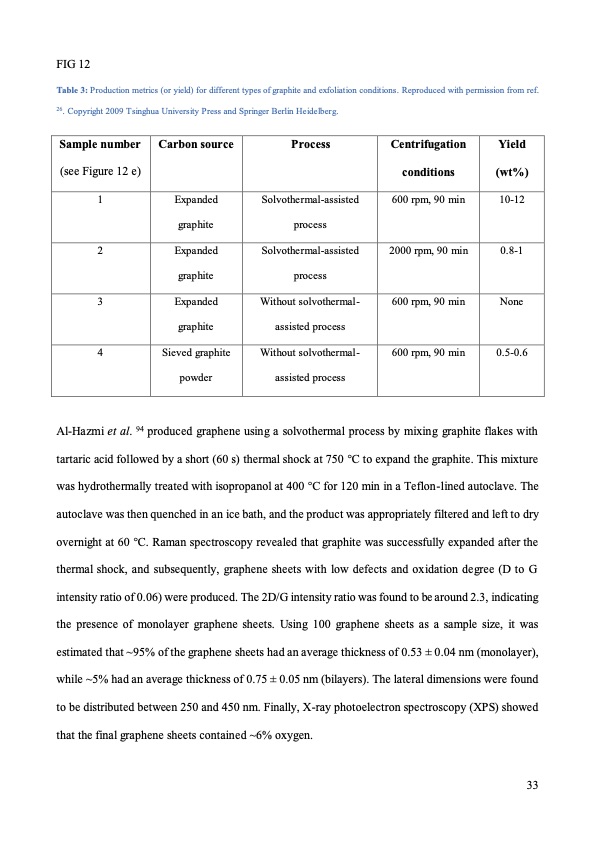
PDF Publication Title:
Text from PDF Page: 033
FIG 12 Table 3: Production metrics (or yield) for different types of graphite and exfoliation conditions. Reproduced with permission from ref. 26. Copyright 2009 Tsinghua University Press and Springer Berlin Heidelberg. Sample number (see Figure 12 e) Carbon source Process Centrifugation conditions Yield (wt%) 1 Expa nded graphite Solvothermal-assisted process 600 rpm, 90 min 10-12 2 Expa nded graphite Solvothermal-assisted process 2000 rpm, 90 min 0.8-1 3 Expa nded graphite Without solvothermal- assisted process 600 rpm, 90 min None 4 Sieved graphite powder Without solvothermal- assisted process 600 rpm, 90 min 0.5-0.6 Al-Hazmi et al. 94 produced graphene using a solvothermal process by mixing graphite flakes with tartaric acid followed by a short (60 s) thermal shock at 750 °C to expand the graphite. This mixture was hydrothermally treated with isopropanol at 400 °C for 120 min in a Teflon-lined autoclave. The autoclave was then quenched in an ice bath, and the product was appropriately filtered and left to dry overnight at 60 °C. Raman spectroscopy revealed that graphite was successfully expanded after the thermal shock, and subsequently, graphene sheets with low defects and oxidation degree (D to G intensity ratio of 0.06) were produced. The 2D/G intensity ratio was found to be around 2.3, indicating the presence of monolayer graphene sheets. Using 100 graphene sheets as a sample size, it was estimated that ~95% of the graphene sheets had an average thickness of 0.53 ± 0.04 nm (monolayer), while ~5% had an average thickness of 0.75 ± 0.05 nm (bilayers). The lateral dimensions were found to be distributed between 250 and 450 nm. Finally, X-ray photoelectron spectroscopy (XPS) showed that the final graphene sheets contained ~6% oxygen. 33PDF Image | graphene production via nonoxidizing liquid exfoliation

PDF Search Title:
graphene production via nonoxidizing liquid exfoliationOriginal File Name Searched:
Graphene-R2-review.pdfDIY PDF Search: Google It | Yahoo | Bing
Salgenx Redox Flow Battery Technology: Power up your energy storage game with Salgenx Salt Water Battery. With its advanced technology, the flow battery provides reliable, scalable, and sustainable energy storage for utility-scale projects. Upgrade to a Salgenx flow battery today and take control of your energy future.
| CONTACT TEL: 608-238-6001 Email: greg@infinityturbine.com | RSS | AMP |